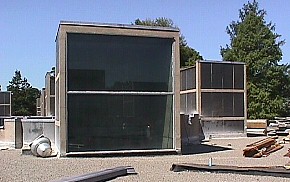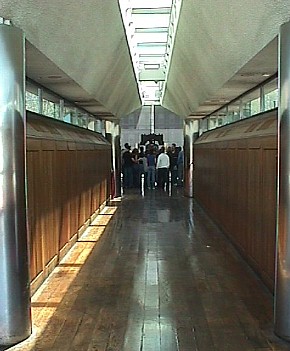| |

2005.05.03 15:02
Minimalism in Architecture
Back in 1977, I and a small group of fellow arch. students got a private tour of Kahn's Esherick House. You could say it's a nice little minimal work, inside and out--I'd move in in a minute. What was shocking, however, was the kitchen, which is totally a design by the wood sculpture Esherick (who was somehow related to the original owners). The whole room is like a room size free-flowing and curvy wood sculpture. The then owners said they had known Kahn when they bought the place, and whenever he visited he couldn't stand to stay in the kitchen more than a few seconds, and being in the room always made him say something nasty.
| |
2005.05.20 16:24
hotrod architecture
Picking up on "stealth communication with other experts," I'm recalling a detail from Kahn's Esherick House. I think in the hall right as you enter the house there is a light switch panel unlike anything I've ever seen before. Not only are there like eight toggle switches in a row, but the panel is set on the wall vertically, as opposed to the traditional horizontal mounting. Granted this is just a small detail, but, given that the building dates from 1959-61, such a light switch panel seems extreme (and I certainly thought that when I first saw it in 1977), but also elegantly simple in its execution.
While I'm "in" the Esherick House, the windows here also have an extreme-ness to them, and these windows are very much integral to the architecture.
And now I'm thinking of the enormous light hoods that "light" the communal spaces of Kahn's Erdman Hall dormitory at Bryn Mawr. Again there is this extreme-ness in terms of how light enters the space, and the resultant effect is very much part of what makes Kahn's architecture "great".

And now thinking further about "windows," my favorite panes of glass remain those at either end of the quondam Liberty Bell Pavilion (vintage 1976). While not a makeover, per se, the detailing of this building has an extreme-ness to it overall, even to the point where the roof/ceiling is split right down the middle so as to not disrupt the axis of Independence Hall. And even aesthetically, if you look at this building closely, it wouldn't be a stretch to say it has a 'hot rod' feel to it. And, as to performance, as much as most didn't like the building, representatives of the National Park Service will nonetheless admit that it served its purpose of allowing thousands and thousands of visitors to see, stand by, and touch the Liberty Bell very well.

Anyway, I never expected to be thinking about Kahn and Mitchell/Giurgola architecture in conjunction with "hot rodding", so again, "Who knew?"
| |
2011.03.18 13:06
visited Kahn's grave today
Kahn is buried at Montefiore Cemetery. It's in Rockledge (with a Jenkingtown zip code, I think), and more or less in my neighborhood now. I learned that Kahn was buried there a couple years ago, but never pursued it further. Since Kahn's death day was yesterday, and it was a really nice day here, I decided to go find his grave. And that's what I did. Turns out the grave is within easy eyesight of a road I've driven down innumerable times over the last 30 years.
While on my walk through Pennypack Park this morning, I tried to think of what Kahn building is now closest to his grave, and I think it's the Oser House in Elkins Park. The next closest would be either Pennypack Woods housing and commons, Ahavath Israel, Esherick House, Korman House or Fisher House.
|